
Warehousing Services: Meaning, Types, and Functions
Warehousing plays a crucial role in the logistics and supply chain management of businesses across various industries. It serves as a pivotal node in the distribution network, facilitating the storage, handling, and movement of goods from production to consumption. In this article, we delve into the meaning, types, and functions of warehousing services, shedding light on their significance in today's dynamic business landscape.
Meaning of Warehousing Services:
Warehousing Services in India encompass a range of activities aimed at efficiently managing inventory within a designated storage facility. These services involve the physical handling, storage, and tracking of goods, ensuring their availability for timely distribution as per demand. Warehouses act as intermediaries between producers and consumers, providing a buffer to balance supply and demand fluctuations.
Types of Warehousing Services:
-
Public Warehouses: These are third-party facilities that offer storage and handling services to multiple clients on a short-term or long-term basis. Public warehouses are equipped with various amenities such as forklifts, pallets, and security systems, allowing businesses to store their goods without the need for owning or managing their storage infrastructure.
-
Private Warehouses: Owned and operated by individual companies, private warehouses are dedicated facilities exclusively used for storing their own products. Private warehouses offer greater control and customization options, enabling businesses to tailor storage and handling processes to their specific requirements. While they require significant upfront investment, private warehouses provide companies with greater autonomy over their inventory management.
-
Bonded Warehouses: Bonded warehouses are authorized by customs authorities for storing imported goods under customs control without payment of duties. These warehouses are particularly beneficial for businesses involved in international trade, as they allow for the deferral of customs duties until the goods are released for domestic consumption or re-export.
-
Distribution Centers: Distribution centers serve as centralized hubs for receiving, sorting, and redistributing goods to various locations based on customer orders. These facilities are strategically located to minimize transportation costs and optimize delivery times. Distribution centers play a vital role in the supply chain by streamlining the flow of goods from manufacturers to retailers or directly to end consumers.
-
Temperature-Controlled Warehouses: These specialized facilities are equipped with climate control systems to maintain specific temperature and humidity levels suitable for storing perishable goods such as food, pharmaceuticals, and chemicals. Temperature-controlled warehouses ensure the preservation of product quality and integrity throughout the storage period, safeguarding against spoilage or degradation.
-
Automated Warehouses: With advancements in technology, automated warehouses utilize robotics, conveyor systems, and advanced software algorithms to automate various warehouse operations such as picking, packing, and sorting. These facilities improve operational efficiency, reduce labor costs, and enhance order accuracy through the implementation of automated material handling processes.
Functions of Warehousing Services:
-
Storage: The primary function of warehousing services is to provide secure storage facilities for goods awaiting distribution. Warehouses employ various storage systems such as pallet racks, shelving units, and mezzanine floors to optimize space utilization while ensuring easy accessibility to stored items.
-
Inventory Management: Warehouses play a crucial role in inventory management by tracking stock levels, monitoring product expiry dates, and conducting regular inventory audits. Effective inventory management ensures adequate stock availability to meet customer demand while minimizing carrying costs and the risk of stockouts.
-
Order Fulfillment: Warehousing services facilitate order fulfillment by picking, packing, and shipping products as per customer orders. This involves retrieving the required items from storage, packaging them securely, and coordinating with logistics providers for timely delivery to customers' designated locations.
-
Cross-Docking: In distribution centers, cross-docking is a process where incoming goods are unloaded from inbound vehicles, sorted, and immediately loaded onto outbound vehicles for onward delivery without storage in between. This streamlined approach minimizes inventory holding times and reduces handling costs, enabling faster order processing and delivery.
-
Value-Added Services: Warehousing facilities often offer value-added services such as labeling, kitting, assembly, and quality inspection to meet specific customer requirements. These additional services add value to the supply chain by enhancing product presentation, customization, and compliance with regulatory standards.
-
Risk Management: Warehouses implement various risk management measures to safeguard stored goods against theft, damage, or environmental hazards. This includes implementing security systems, fire suppression systems, and insurance coverage to mitigate potential risks and ensure the safety and security of stored inventory.
Conclusion:
Warehousing Services in India play a pivotal role in the efficient management of goods within the supply chain, offering storage, handling, and distribution solutions to businesses across diverse industries. By understanding the meaning, types, and functions of warehousing services, businesses can optimize their logistics operations, improve inventory management, and enhance overall supply chain performance in today's competitive business environment.